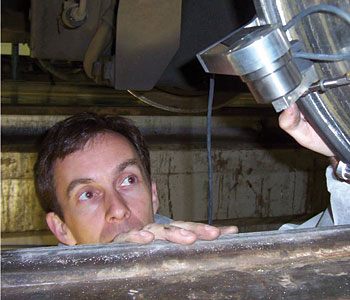Track to the future
Thu, 02 Aug 2012 12:37:00 BST
Professor will make University of Huddersfield a leading centre for railway research
THE investment package of £9.4bn in track, electrification and station improvements, recently announced by the Government, provides evidence that rail transport – pioneered in Britain almost 200 years ago – is of increasing importance to the UK. And a 12-strong research team, headed by Professor Simon Iwnicki at the University of Huddersfield, will play a key role in ensuring that track and trains move with the times.
 Professor Iwnicki (pictured) – a leading figure in the field of railway engineering – is establishing an Institute of Railway Research at the University. It will be based in specially-rebuilt and equipped laboratories, where critical and complex engineering problems associated with rail transport will be investigated.
Professor Iwnicki (pictured) – a leading figure in the field of railway engineering – is establishing an Institute of Railway Research at the University. It will be based in specially-rebuilt and equipped laboratories, where critical and complex engineering problems associated with rail transport will be investigated.
“We will be carrying out some innovative work aimed at identifying in detail what happens in the contact patch between the wheel and the rail,” says Professor Iwnicki. “It is a very challenging interface. In fact, it has been described as one of most challenging in all engineering.”
Few people, when they see a train in motion, think about the nature of the contact between rolling stock and track, adds Professor Iwnicki.
“As the wheel passes over the rail, the contact is about the size of a thumbnail and it is moving so fast that it passes a point on the rail in milliseconds and during that point it has to support and guide many tons of load.”
Consequently the steel track is distorted in ways that are still not fully understood. But Professor Iwnicki’s team is pressing ahead with research which should lead to greater understanding of wheel-rail contact. One result of this will be better and more cost-effective maintenance techniques.
“We will look at new materials, but steel-on-steel has been around for 200 years and generally provides a very cheap and effective and a very safe solution,” said Professor Iwnicki. “It is a matter of optimising the amount of money that is spent on inspection and maintenance, which can cost billions of pounds every year. If a small percentage can be taken off that then there will be enormous spin-off benefits to the railway companies and all their customers.”
Now, with his team, he will be working towards new levels of knowledge. And there will be research collaboration with the multi-national Tata Steel company, in order to investigate new materials.
 It was after he had graduated in mechanical engineering at Manchester University and worked as a researcher for a company that manufactured electric vehicles that Simon Iwnicki’s interest in rail transport began. In the late 1980s he obtained a PhD scholarship sponsored by the National Coal Board, which at the time ran a huge network of underground railways that took miners long distances to the coal face. The research project was to investigate the use of solid rubber tyres to provide traction and smooth out the ride on these uneven tracks and it alerted the future Professor Iwnicki to the wide range of technical challenges raised by rail transport.
It was after he had graduated in mechanical engineering at Manchester University and worked as a researcher for a company that manufactured electric vehicles that Simon Iwnicki’s interest in rail transport began. In the late 1980s he obtained a PhD scholarship sponsored by the National Coal Board, which at the time ran a huge network of underground railways that took miners long distances to the coal face. The research project was to investigate the use of solid rubber tyres to provide traction and smooth out the ride on these uneven tracks and it alerted the future Professor Iwnicki to the wide range of technical challenges raised by rail transport.
However, he said, “You don’t have to have been a train-spotter or have an interest in the romance of steam! There are lots of real engineering challenges that are faced by railways today, such as energy efficiency and recovery, very high speeds and improved materials.”
Professor Iwnicki’s research group, now fully relocated to the University of Huddersfield, has recently been funded to the tune of £1 million a year – much of the investment coming directly from railway companies. Also, the team is assembling a bid for funding from a research council for a project that would look at the problems of very high speed travel – the human factors as well as the engineering issues.
As the deputy chair of the Railway Division of the Institution of Mechanical Engineering, Professor Iwnicki is very keen to attract younger people into rail engineering. For this reason he played a central role in setting up the Institution’s new Railway Challenge competition in which teams of students and from industry are invited to design a cutting-edge 10-and-a-quarter inch gauge locomotive and enter it for a series of tests and challenges.
Interesting designs – including a loco powered with a hydrogen fuel cell – emerged at the inaugural contest this year. And Prof Iwnicki is determined that in 2013 there will be a University of Huddersfield entrant.







